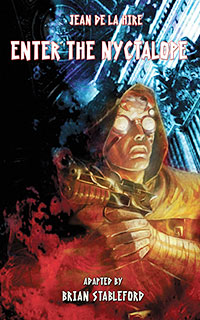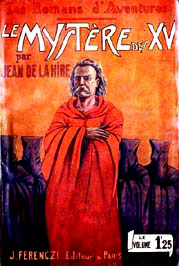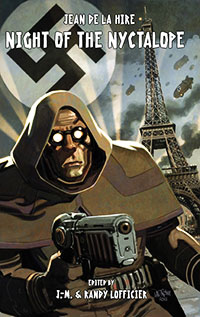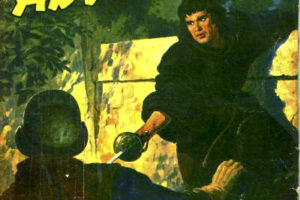 The Nyctalope is an overlooked French proto-superhero/proto-pulp adventurer that was featured in a series of serialized novels and stories during the first half of the 20th century.
The Nyctalope is an overlooked French proto-superhero/proto-pulp adventurer that was featured in a series of serialized novels and stories during the first half of the 20th century.
Due in part to the author working with the Vichy government during WWII, both he and his character fell out of popularity.
Now, Black Coat Press has been slowing bringing the character back with translations of the original stories and new ones by several authors in their “Tales of the Shadowmen” series. There has been an attempt to fit all these stories into a coherent chronology, and explain or fix some of the problems in the stories.
The Nyctalope is really Léo Saint-Clair. He has the ability to see in the dark, hence his name. He also has an artificial heart, which seems to also imbid him with vitality and a bit of longevity (though this is not mentioned in the first novel, so this is something the author added later to the character, but I’m not sure when).
He embarks on a life of adventure, both on the Earth and on other worlds, and as a patriotic Frenchman, working for his government as a sort of special agent.
In the first novel, he is referred to more as an explorer, having traveled in Tibet and in Central Africa, less so than being an adventurer or heroic (it’s even noted that he is no detective). It should be clear that he has no alter ego. The name “The Nyctalope” is more a nickname than a superhero name, as everyone knows who he is.
The stories in this series are:
- “L’Homme Qui Peut Vivre dans l’Eau” (“The Man Who Could Live Underwater”) (1909) — features only Léo’s father
- “Le Mystère des XV” (“The Mystery Of The XV”) (1911) — first adventure) (translated by Brian Stableford as “The Nyctalope on Mars” Black Coat Press
- “Lucifer” (1921–22) — translated by Stableford as “Nyctalope vs Lucifer” Black Coat Press
- “L’Amazone du Mont Everest” (“The Amazon Of Mount Everest”) (1925)
- “La Captive du Démon” (“The Demon’s Captive”) (1927)
- “Titania” (1929)
- “Belzébuth” (1930)
- “Gorillard” (1932)
- “Les Mystères de Lyon” (“The Mysteries of Lyon”) (1933)
- “L’Assassinat du Nyctalope” (“The Assassination of the Nyctalope”) (1933) — translated by Stableford as “Enter The Nyctalope,” Black Coat Press
- “Le Sphinx du Maroc” (“The Moroccan Sphinx”) (1934)
- “La Croisière du Nyctalope” (“The Nyctalope’s Cruise”) (1936)
- “Le Mystère de la Croix du Sang” (“The Mystery of the Cross Of Blood”) (1941)
- “L’Enfant Perdu” (“The Lost Child”) (1942) — translated by Jean-Marc Lofficier and Randy Lofficier in “The Nyctalope Steps In,” Black Coat Press
- “Le Roi de la Nuit” (“The King Of The Night”) (1943) — translated by Stableford in “The Return of the Nyctalope,” Black Coat Press
- “Rien qu’une Nuit” (“Only One Night”) (1944) — translated by the Lofficiers in “Night of the Nyctalope,” Black Coat Press
- “La Sorcière Nue” (“The Naked Sorceress”) (written c. 1940+; publ. 1954)
- “L’Énigme du Squelette” (“The Enigma of the Skeleton”) (written c. 1940+; publ. 1955)
Most of the stories are novels, but a few during WWII are short stories. As the author, Jean de La Hire, remained in France, he had the Nyctalope still operating under Vichy France. There were two novels written during the war that were later published in the 1950s by the author’s son. At present, Black Coat Press has only translated a few stories.
“The Nyctalope on Mars” (1911) is the first Nyctalope novel, but is actually the second in the general series (more on why shortly). As this is an early SF adventure, before many conventions we are used to came into use, the story is a bit rough. Brian Stableford has tried to fix these, and the notes and explanatory materials explain the issues with the work. One is the time placement of the story. Less easy to fix are how the characters act.
I said this is the second story in the Nyctalope series, but the first Nyctalope story. This is because this novel is actually the sequel to two others. One is La Hire’s own earlier novel, “The Man Who Could Live Underwater” (1908), in which Léo’s father went up against Oxus (the main villain in this story) who had created the Hictaner, a man-shark who could breath underwater. (Black Coat Press has not reprinted this earlier story, nor given any indication of doing so, but who knows). There are clear references to that earlier story in this book (and it even reprints an early book cover of it), and we learn that Léo’s adopted sister is in fact the daughter of the Hictaner and Oxus’ daughter.
And I said this novel is the sequel to a second work, and that is H.G. Well’s “War of the Worlds”! References are made to the events of that story, which makes it clear that it really happened in the world of the Nyctalope, and that the Martians would be dealt with on Mars. However, it seems that the events of “WOTW” only affected England, not the rest of the world.
 The basic storyline is that Oxus, after the events of the early work (set about 25 years prior), set out to establish a group called the “Society of the XV,” among them being Koynos, a rival to the Nyctalope. In setting up their colony on Mars, the XV kidnap 15 girls to take as their wives. Koynos has kidnapped Xaviere de Ciserat, who is the fiance of Léo Saint-Clair — which, of course, causes the Nyctalope to try to find her.
The basic storyline is that Oxus, after the events of the early work (set about 25 years prior), set out to establish a group called the “Society of the XV,” among them being Koynos, a rival to the Nyctalope. In setting up their colony on Mars, the XV kidnap 15 girls to take as their wives. Koynos has kidnapped Xaviere de Ciserat, who is the fiance of Léo Saint-Clair — which, of course, causes the Nyctalope to try to find her.
To do so, Léo must travel to Mars and fight the XV. And this takes up a good bit of the first half of the book. The XV have setup a base in the Congo from which they have a radio transmitter whose radio waves are what drive their “radioplanes” to Mars (no rocket ships here!). Saint-Clair and company must contend with Koynos and other agents of the XV trying to stop them. They almost do so, when they throw Saint-Clair out of the dirigible they are flying in. Instead he is rescued and hooks up with a reclusive English engineer in the Baleric islands who is building a new kind of airship, an “aeronef,” which is propelled by the flapping of its wings! With it, Saint-Clair and group are able to get to the Congo and capture the XV’s base before it’s destroyed (which would prevent any pursuit).
Once on Mars, they land in the northern hemisphere (the XV’s base is on an island in the southern hemisphere), and begin their work to defeat them and rescue the girls. This takes up another good chuck of the novel, as Saint-Clair works mostly alone to overthrow the rule of Oxus. After a contrived affair, he does so, then unites the XV with his people and 3,000 soldiers newly arrived from Earth to fight the evil Martians seen in the “War of the Worlds.”
The final part of the novel is the war against the Martians. However, things don’t go as one might expect. Another Martian race is discovered, a less-intelligent bipedal race that the Martians use as cattle to suck blood from. And instead of conquering the Martians, rather the Earthmen learn to communicate with them, and establish a treaty. It is learned there are three Martian nations: one that controls the southern hemisphere, and two in the northern. And it was one of the northern nations that tried to attack the Earth, so it turns out that the other two nations are not belligerent toward the Earthmen.
Peace obtained, the existence of the French colony is made known, and it’s to be expanded. We know from later stories that Léo marries Xaviere and has two children by her. (The colony, along with Xaviere and her children are mysteriously wiped out. The new Nyctalope stories that have appeared in the later collections from Black Coat Press gives that story.)
We have some extras in this book. We get the covers of the original two volume book publication, and the later two volume reprint of the 1950s, along with the covers of the prior “The Man Who Could Live Underwater” as well as the cover for another La Hire work.
Ten years later, the next Nyctalope novel came out, “Nyctalope vs. Lucifer” (1921-22). De La Hire was writing other stories in the meantime, such as The Black Corsair, an 80-volume series of a Captain Nemo-like character. In this novel, available from Black Coat Press, Saint-Clair goes up against Baron Glô von Warteck, a.k.a. Lucifer, who is trying to take over the world with his hypnotic powers.
This begins a series of novels having the Nyctalope going up against various super threats to the world. He finds a lost civilization of Amazons in Tibet. He goes up against Leonid Zattan, Lord of Issyk-Koul, a forbidden city located in Tien-Chan, and Red Princess Diana Ivanovna Krasnoview. He also sets up CID, a private crime fighting group, and meets several associates who will work with him in future stories: Japanese diplomat Gno Mitang and his Cosican assistants Soco and Vitto. Diana comes back as Titania, and her son will appear as Belzébuth. There is also Gorillard and Alouh T’Ho, a Chinese Empress born in 1852. As yet, none of these have been translated, but hopefully soon.
“Enter the Nyctalope” (“L’Assassinat du Nyctalope”) gives his origin story. It is actually the 10th story in the series. And I was actually a little surprised by the story. Not having read any of the original stories when I read this one, it struck me as a little strange. Almost like a “boy’s adventure story” than what I expected. Léo’s father is a research scientist (a re-write from previously, where he was more a naval man and diplomat), who is attacked by “nihilists” who want his latest invention, injuring him in the process.
Now, I think most people today would not understand what a nihilist is. The term was used for the general Russo-Asian communists of the early 20th century, who were cast as the villains of many works.
Léo, who is only 20 at the time, decides to team up with three of his classmates to go after the villains. As they are not yet 21, they need to get their parents approval (which is given) and are even helped by the government who gives them documents and codes, along with the assistance of a young French agent of Polish extraction (all of which is very surprising).
While chasing down the villains to the Lake Geneva area, Léo is injured by a gun shot (and their Polish assistant is kidnapped. It’s later assumed he is killed and the body is disposed, but no one seems too upset about this). Thankfully, a passing vehicle has a doctor who takes Léo to his clinic. Initially thought to be blind, Léo later not only regains his sight, but he can see in the dark! He has become the Nyctalope!
After recovering, Léo goes undercover as a would-be revolutionary, hoping to be taking in by the nihilists (he is, and the ones with his father’s secrets). But he is betrayed when the nurse at the clinic is shown to be in league with the nihilists and gives him away. He is tortured, and as his friends rescue him, is stabbed in the heart! But taken back to the clinic, the doctor is able to replace his heart with an artificial one that he just happened to be perfecting. Léo is now and forever the Nyctalope. (Of course, the lucky turns are a bit much.)
In addition to this story are several new stories of the characters, two of which saw print in volumes of the “Tales of the Shadowmen” series that I have reviewed previously:
“Black and Gold,” by Emmanuel Gorlier, has Léo meeting with La Hire, allowing him to write stories based on his life. He is also given a mission by French authorities to capture a dangerous bacteria, created by the Black Corsair (another character created by La Hire) who had worked with Dr. Natas (a Fu Manchu pastiche used in the “Tales of the Shadowmen” series).
“Marguerite,” by Jean-Marc Lofficier,first appeared in “Tales of the Shadowmen” #2. It is a very short story set during WWII with Léo shielding a downed Allied pilot from the Vichy forces.
“The Heart of a Man,” by Roman Leary, appeared in “Tales of the Shadowmen” #5. This story set during Léo’s self-imposed exile in Argentina (to avoid being arresting by the post-WWII French authorities for collaboration with the Nazis, as he had allied himself with the Vichy government). Here he is met by Blofield who is setting up SPECTRE and trying to recruit Léo to it. He passes.
There is also an afterward delving into the issues of continuity of the works of La Hire.
“The Nyctalope Steps In” (Black Coat Press) publishes one of the four stories written during the occupation of France. It’s the 14th story in the series. During the occupation period, he worked with the Vichy government, as he felt that was his duty.
“The Nyctalope Steps In” (original title is “L’ Enfant Perdu,” which translates as “The Lost Child”), by Jean de La Hire, is from 1942. I found this one a strange story. It is very, well, ordinary. The story has two parts. The first is set during the “exodus” when French civilians were fleeing the Nazis. Léo, along with his friend the Japanese diplomat Gno Mitang, are on a secret mission to the city of Orleans (which is not revealed and has no bearing on the story). Along the way they see a child that stands out, who is with his guardian. The child mysteriously disappears, and the guardian, in pursuit of another car, is killed when the bridge she drives over blows up!
Two years later, the two are in the general area again, when they see things that lead them to restart the hunt for the child, who appears to be a possible genius. It seems that a distant relative engineered the kidnapping to do away with the child and come into possession of millions, and engaged gypsies to do so, who have mistreated the child at a circus. But Léo and Gno rescue the child and put an end to the villains.
Again, considering that this story was more in the line of a standard mystery, it seems a waste for a character like the Nyctalope to deal with.
The rest of the volume is taken up by several original tales, including several that originally appearing in “Tales of the Shadowmen.” This, along with the stories in “Enter the Nyctalope” are all the new stories of the Nyctalope from that series. These stories are arranged by their chronology.
“Fiat Lux!” (previously published in Tales of the Shadowmen #7), by Gorlier, doesn’t deal with Léo, but with his ancestors and shows that the power of the Nyctalope is something that has been passed along in his family for thousands of years, to emerge when needed.
“The Three Sisters,” a sort of sequel to “Fiat Lux” and also by Gorlier, deals with a trio of very dangerous stones that his ancestors deals with and Léo must later deal with in 1958. This was after he surrendered to French authorities (he was condemned as a WWII collaborator) and pardoned.
“The Season of the Shark,” by Julien Heylbroeck, doesn’t deal with Léo, but with the Hictaner, the shark-man created by Oxus whom Léo’s father dealt with in a novel (“The Man Who Could Live Underwater”). Here, the Hictaner must stop an attempt at using Dagon and the Deep Ones, which leads to the death of himself and his wife.
“The Lesson of Captain Danrit,” by Gorlier, deals with a discussion between Léo and his oldest son, Pierre, based on Léo’s meeting of Col. Driat, who wrote under the name of Capt. Danrit (this is a real person, btw). This explains why Pierre instead joined the Free French forces after France surrendered.
“The Hunters of Mars,” by Matthew Dennion, is set during the time that Léo was on Mars as part of the French colony. Here he meets with John Carter of Mars, as they deal with an Predator (yes, from the movies). It also sets up what happened to that colony, and that Mars actually contained several of the fictional Martian races.
“The Children of Heracles” (previously published in “Tales of the Shadowmen” #6), by Roman Leary, is set in 1949 when Léo was wandering the American Southwest (after leaving Argentina), but it also explains what wiped out the French colony on Mars. It ties in with the Martian capsule seen in “Quatermass and the Pit” and this story has Prof. Quatermass as well as The Master (from “Doctor Who”).
“The English Gentleman’s Ball” (previously published in “Tales of the Shadowmen” #5), by Randy Lofficier, deals more with Léo’s future wife Sylvie MacDhul. Here, the Phantom Angel (really, Sleeping Beauty, who was awaken by Doc Ardan in “Tales” #4), works to rescue her from her evil stepmother, revealed to be Belphegor, the Phantom of the Louvre (villain of the French serial “Belphegor,” whose novelization Black Coat translated). Also appeared are Jeeves and Wooster.
“Death to the Heretic!” (previously published in “Tales of the Shadowmen” #7), by Paul Hugli, puts Léo in Egypt in 1929, where he has an adventure with a young Indiana Jones and a young Bruce Wayne.
“The Nyctalope’s New York Adventure,” by Stuart Shiffman, has Léo in New York in the 1930s on the trail of the new Zigomar (a classic French movie villain who pre-dates others like Fantomas). There he meets The Shadow (in his identity of Henry Arnaud) and Nero Wolf.
“A Present for Hitler,” by Gorlier, has Léo going on a mission during WWII for the Nazis to retrieve the Standard of the Teutonic Knights from Russia, teamed up with Dr. Strangelove and Captain Maciste (the Warrior, a character from an Italian silent film).
“Twilight,” by Gorlier, is a story dealing with Léo’s Japanese friend Gno Mitang, who must decide if Godzilla can be used as a final weapon against the Americans.
“A Moment of Perfect Happiness,” by Roman Leary, has Léo again meeting the doctor who gave him his artificial heart in Vietnam in 1951, and learns more about why he doesn’t age much.
“The Mysterious Island of Dr. Antekirtt” (previously published in “Tales of the Shadowmen” #7), by David L. Vineyard, is set in the mid-1950s. It has Léo team up with Bernard Prince and Bob Morane, two French adventure characters, against Dr. No (James Bond) and M. Ming (aka the Yellow Shadow, Bob Morane‘s foe) in trying to gain the secrets of Dr. Antekirtt. Dr. Antekirtt is a Jules Verne character, a sort-of combination of the Count of Monte Cristo and Captain Nemo. The island was his secret base as a science pirate.
“Out of Time” (previously published in “Tales of the Shadowmen” #6), by Gorlier, explains how in Belzebuth the hero and his friend travel to the future via suspended animation, but someone he winds up back home after waking up.
In addition to the stories are a few other items:
“The Nyctalope Chronology” by Gorlier, is a great work. It has a complete chronology that incorporates not just the original stories by La Hire, but also the new stories that have appeared in “Enter” and “Steps In.” I hope that this chronology can be updated and included in future collections. Gorlier seems to have really taken a lead in this.
“Bibliography of the Nyctalope” novels also includes secondary works of La Hire that tie in.
“Return of the Nyctalope” is the most recent volume and includes the 15th Nyctalope story “Le Roi de la Nuit” (“The King Of The Night”), published in 1943, but clearly set earlier.
This story tells of Léo working with a French scientist who discovers a mysterious attraction between a new alloy he has created and a recently discovered planetoid called “Rhea.” This metal almost acts similar to the anti-gravity metal Cavorite from Well’s story. They then embark on creating a spacecraft “fueled” by this metal to travel to this planetoid. The spacecraft is built, and the Nyctalope along with his two Corsican companions and his friend, the Japanese Ambassador Gno Mitang, and others including the scientist’s daughter (who the Nyctalope has fallen in love with and who will become his fourth wife), travel to the planetoid.
There they discover two races: the ape-like Nocturnals and the bat-like Diurnals. They broker a peace between them, with the added issue of one of the Nyctalope’s companions trying to betray them. After staying on the planetoid for a year, they return to Earth.
This volume has a new sequel story set in 2014, where the Nyctalope returns to Rhea to battle a new evil. We learn that during WWII, the Nyctalope setup a colony of earthmen in secret on Rhea. And Rhea itself is under threat by an evil that the Nyctalope himself had once confronted. We learn more about the strange planetoid as well. Overall, I thought the story was pretty good, though it took a few liberties from what had previously been set. We also have a group called the “New XV,” which are mainly composed of people who have connections with the Nyctalope (usually he had helped an ancestor or the like), but they weren’t used to their fullest here.
As an added bonus, we get a short chronology of the Nyctalope’s adventures that tie in with Rhea.
I did find it strange that in the first story that despite the fact that the Nyctalope had previously visited Mars, no mentioned was made of that. And like that story, we have a spacecraft that is not rocket propelled. I am also a little puzzled that the Nyctalope’s artificial heart is never mentioned.
“The Night of the Nyctalope” (Black Coat Press) publishes the last of the four stories written during the occupation of France. It’s the 16th in the series.
 De La Hire’s “Night of the Nyctalope” (original title: “Rien qu’une Nuit,” which translates as “Only one Night”) is from 1944. Again, it’s another unlikely Nyctalope story. Here Gno Mitang and Léo work to free a young woman from the clutches of a “sorcerer,” who by his mind powers is able to lure her to his home, probably with the thought of making her is wife. Léo and Gno are able to overcome him and turn him over to the authorities. Again, it’s a short Nyctalope story.
De La Hire’s “Night of the Nyctalope” (original title: “Rien qu’une Nuit,” which translates as “Only one Night”) is from 1944. Again, it’s another unlikely Nyctalope story. Here Gno Mitang and Léo work to free a young woman from the clutches of a “sorcerer,” who by his mind powers is able to lure her to his home, probably with the thought of making her is wife. Léo and Gno are able to overcome him and turn him over to the authorities. Again, it’s a short Nyctalope story.
The rest of the volume has new stories, arranged in terms of internal chronology:
“First Steps,” by Travis Hiltz, is set in 1900, soon after Léo becomes the Nyctalope, as he tries to set out on his path. He uses his vision power to unmask the fakes that run seances, until he encounters the real thing! He is briefly aided by Sar Dubnotal, an early French psychic detective (Black Coat Press has put out one volume of his original stories, and he has been used in several new stories in the “Tales of the Shadowmen” series). He is also assisting the mother of Indiana Jones, though he doesn’t know it.
“The Angel and the Exorcist,” by Dennion and set in 1906, does not deal with Léo, but his foe Lucifer (from the second Nyctalope novel). Here Lucifer is prevented by the Ogon Bat (a character from Japanese fiction who is similar to Batman, but pre-dates him) to obtain a ring of power in Egypt.
“Dangerous Territory,” by Dennion and set in 1909, has Léo in Africa where he must deal with his rival Koynos (who would later join the XV, the villains of “Nyctalope on Mars”), and they both must deal with an ape man!
“Dam Busters of Mars,” by Martin Gately and set in 1911, has Léo on Mars as part of the French colony, and working with Gullivar Jones (an early pulp hero similar in many ways to John Carter of Mars) to stop a major threat.
“Justice and Power,” by Chris Nigro, is set in 1917 during WWI, shortly after the demise of the French colony on Mars. It deals with the Nyctalope encountering Judex as well as why he doesn’t recall what happened to wipe out the colony (as revealed in stories in “Nyctalope Steps In”).
“The Girl From Odessa,” by David McDonald, is set in Odessa in 1919. This is a sort-of sequel to some stories in “Tales of the Shadowmen” starring Léo’s father and the son of Flashman (the character created by George MacDonald Fraser). Here, Léo’s father and the son of Flashman are trying to get a Russian countess out of Odessa, but must content with Koschei the Undying!
“Una Voce Poco Fa,” by Gorlier, is a sequel to a story in “Steps In” and set in 1936. Léo is taking The Phantom Angel (Sleeping Beauty awaken by Doc Ardan in a story in “Tales of the Shadowmen”) when they are attacked by Belphegor.
“The Hour of the Grail,” by Philippe Ward and also set in 1936, has Léo in France dealing with a legend concerning the Cathars.
“Blood and Weapons,” by Heylbroeck and translated by Matthew Baugh, has Léo in western France in 1938, dealing with a case of missing children, and finding a monstrous conspiracy at work.
“The Road Not Taken,” by Dennion, has Léo on a mission in 1942 for Vichy France to stop a possible attack on France lead by G-8 (WWI air pulp hero published by Popular Publications in the U.S.). But to his regret he learns he was mislead as to the nature of the attack.
“Requiem for a Regime,” by Nigro, has Léo in Nazi German in 1945 to help rescue a French archaeologist, when he has an encounter with Dracula. With this story and the prior, the Nyctalope must come to grips with his role with Vichy Franch.
“Showdown at Steam Town,” by Hiltz, takes place in 1949 when Léo is still wandering the American Southwest during his “exile,” when he runs into the characters from “On the Road Again,” who encounter the giant ants of “Them!” and a descendant of Frank Reade (who along with his son, who were the Tom Swift and Tom Swift Jr. of the late 1800s).
“Madison Square Garden,” by Gorlier, features Léo in New York in 1949, where he helps stop a fight fixed by the Godfather.
“The Devil You Know,” by Leary, has Léo back in California in 1950 where he must deal with the monsters from “I Married a Monster from Outer Space.”
Gorlier’s “The Algerian Dilemma” features Léo in Algeria in 1959, a time of unrest against French rule. There he encounters the Djinn, a descendant of a foe he dealt with in an earlier La Hire story.
“The Ides of Mars,” by Jean-Marc Lofficier and set in 2012, once again deals with what wiped out the French colony on Mars, as Léo finally puts this to rest.
Overall I find the character pretty interesting, but I really hope they will translate the earlier stories which seem more fantastical. Check out this series.



